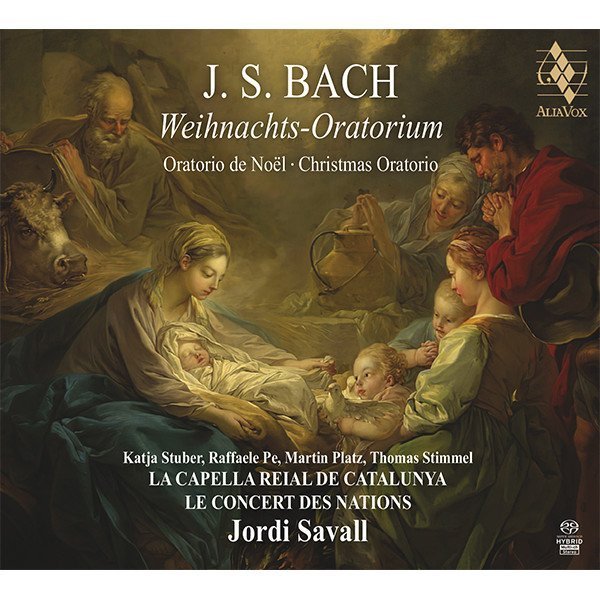J.S. BACH
Weihnachts-Oratorium
Jordi Savall, La Capella Reial de Catalunya, Le Concert des Nations
25,99€
By the end of May, 1723, Johann Sebastian Bach had finally been appointed cantor of the four churches in the historic centre of Leipzig. That moment marked the beginning of the last stage of Bach’s life, undoubtedly one of the most intense from a creative point of view. Over the following six years Bach was to take on the huge task of writing at least four complete cycles of cantatas for the entire liturgical year. In practical terms, this meant composing about sixty cantatas per year corresponding to all the Sundays and holy days of obligation. An impressive feat which, moreover, he had to combine with his responsibility for liturgical services as director of the choir of St. Thomas’s Church.
ALIA VOX AVSA9940
CD1 : 75’44
CD2 : 68’07
J.S. BACH
Weihnachts-Oratorium
Oratorio de Noël – Christmas Oratorio
(BWV 248)
CD1
1-9. I. TEIL – Jauchzet, frohlocket, auf, preiset die Tage 25’52
Am ersten Weihnachtsfeiertag
10-23. II. TEIL – Und es waren Hirten in derselben Gegend 27’03
Am zweiten Weihnachtsfeiertag
24-36. III. TEIL – Herrscher des Himmels, erhöre das Lallen 22’45
Am dritten Weihnachtsfeiertag
CD2
1-7. IV. TEIL – Fallt mit Danken, fallt mit Loben 21’42
Am Feste der Beschneidung Christi
8-18. V. TEIL – Ehre sei dir, Gott, gesungen 23’08
Am Sonntag nach Neujahr
19-29. VI. TEIL – Herr, wenn die stolzen Feinde schnauben 23’14
Am Feste der Erscheinung Christi
Katja Stuber soprano · Raffaele Pe contre-ténor
Martin Platz ténor · Thomas Stimmel basse
LA CAPELLA REIAL DE CATALUNYA
Lluís Vilamajó préparation de l’ensemble vocal
LE CONCERT DES NATIONS
Manfredo Kraemer concertino
Direction : JORDI SAVALL
Enregistré les 17 et 18 de décembre 2019 au Palau de la Música Catalana, Barcelone
Enregistrement, Montage et Mastering SACD : Manuel Mohino (Ars Altis)
A VERY PERSONAL ORATORIO
By the end of May, 1723, Johann Sebastian Bach had finally been appointed cantor of the four churches in the historic centre of Leipzig. Although he was not initially the winning candidate, as the next in line Bach found his path unobstructed when, for various reasons, Georg Philipp Telemann and Christoph Graupner, the first and second choices, respectively, decided not to take up the position. That moment marked the beginning of the last stage of Bach’s life, undoubtedly one of the most intense from a creative point of view. Over the following six years Bach was to take on the huge task of writing at least four complete cycles of cantatas for the entire liturgical year. In practical terms, this meant composing about sixty cantatas per year corresponding to all the Sundays and holy days of obligation. An impressive feat which, moreover, he had to combine with his responsibility for liturgical services as director of the choir of St. Thomas’s Church.
At the end of those first six years, Bach seems to have entered a second creative period. On the one hand, he had produced more than a sufficient number of cantatas to meet the liturgical musical requirements for years to come, during which time he would compose only a fifth complete cycle. He therefore completed a total of three hundred cantatas, of which just over 60% survive. On the other hand, the composer’s thorny relations with the ecclesiastical authorities of that Lutheran community had probably also left him somewhat disenchanted. All of these factors no doubt came into play when in 1729 he accepted the new post of director of the Collegium Musicum, founded in 1704 by Georg Philipp Telemann. It was an amateur orchestra consisting chiefly of students from the University of Leipzig, who rehearsed in one of the rooms of the bustling, centrally located Café Zimmermann. Much of the creative energy that Bach had previously poured into the composition of liturgical material was now turned to preparing the new repertory of the Collegium Musicum, which comprised mainly orchestral works. These were often adaptations of original compositions that Bach had written during the years when he was employed as Kapellmeister in the service of Prince Leopold of Anhalt-Köthen. They were mostly concertos for solo violin or oboe, many of which are now lost, which in Leipzig were transformed into concertos for harpsichord and orchestra. Of course, for special occasions Bach composed a large number of what are today known as secular cantatas, many of which were composed to celebrate significant events in the city of Leipzig, such as festivals or visits by members of the family of August the Strong, the Prince-Elector of Saxony.
+ information in the CD booklet
JOAN VIVES
Musician and music broadcaster
Translated by Jacqueline Minett







Share